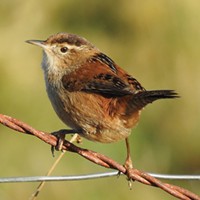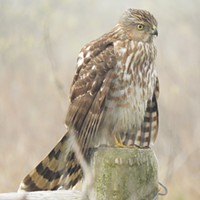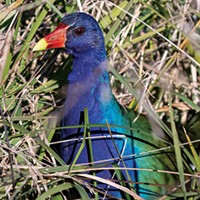[
{
"name": "Top Stories Video Pair",
"insertPoint": "7",
"component": "17087298",
"parentWrapperClass": "fdn-ads-inline-content-block",
"requiredCountToDisplay": "1"
}
]
Until a year ago, I had never seen a burrowing owl (Athene cunicularia). I wasn't even aware we had this species locally — I thought they only lived in the desert. But that all changed in February of 2022 out in the dunes next to the Pacific Ocean.
Out walking on a sunny morning, my wife and I slowly wandered into the dunes covered with beach grass and driftwood looking for a burrowing owl (thanks to a tip from a local birder). Our pre-trip research revealed they winter here in the driftwood on beaches from the mouth of the Eel River to the mouth of Redwood Creek ("A rare but regular winterer" in one local birder's description). Posts on social media from the past several years revealed they'd been infrequently seen on Humboldt Bay's South Spit near Table Bluff, at the Humboldt Bay Wildlife Refuge and in the Eel River delta. In October of 2017, the Humboldt Wildlife Care Center rescued one hanging around the parking lot of a motel in Eureka and later released it in the Samoa dunes.
As their name implies, burrowing owls nest in burrows made by other animals or dig their own, so we looked for burrows in the dunes and under driftwood. Given that the Soulatluk (Wiyot language) name for burrowing owl is rrutsuwubulilh, meaning "eats at night," and they hunt at dusk and dawn using night vision and acute hearing, we weren't sure we'd even see one in late morning light.
As we walked into the dunes, avoiding areas with footprints of other hikers and dogs behind, we looked for a small owl or signs of its regurgitated pellets — the indigestible parts of their prey such as bones and fur. They are opportunistic predators of insects and small mammals, like voles and mice, with males taking most of the vertebrates, typically at night. An average adult (at 7–11 inches) is slightly larger than an American robin, though the burrowing owl has developed longer legs that enable it to sprint as well as fly when hunting.
Finally, we spotted two bright eyes in a small, brown-feathered head peering at us over the top of a large driftwood log. Taking care not to disturb it, we avoided walking directly toward the owl and circled it at a distance until we could clearly see its entire body. Excited to add it to our bird "life list," we scanned it through binoculars and my telephoto lens.
Guidebooks describe the beaks of burrowing owls as dark yellow or gray, depending on the subspecies. They lack ear tufts and have a flattened facial disc. The owls have prominent white eyebrows and a white "chin" patch they expand and display during certain behaviors, such as head bobbing when agitated.
We could clearly see its wings with white spotting and its white with variable brown spotting or barring chest and abdomen, and those long, grayish legs.
Males and females are similar in size and appearance. Females tend to be heavier, but males tend to have longer wings and tails. Adult males appear lighter in color because their feathers become "sun-bleached" outside the burrow during daylight (especially in desert locations).
The specimen we discovered seemed undisturbed by our presence as it scanned the sky and looked around in all directions. As I slowly moved around taking photographs with my telephoto lens, it kept me in sight at all times. When a distant hiker with an unleashed dog walked by, the owl first stretched upright on its long legs and flew only a few feet above ground to a nearby grassy dune.
Trying to avoid further disturbing the owl, we hiked further into the dunes looking for others. Finding none, we returned in an hour or so and saw the owl again perched on the same log.
Last month, on another mild sunny day between rain and snowstorms, we returned to the same location and spotted another burrowing owl perched on that same driftwood log. Again approaching stealthily, we scanned the owl with our binoculars and telephoto lens, and wondered if it could be the bird we had seen the year before.
To our amateur bird-watching eyes, this owl looked very similar to the one we'd seen a year ago — until we spotted the large metal band on its right leg. I contacted Frank Fogarty III, wildlife professor at Cal Poly Humboldt. He replied by email that if this owl was the same one we'd seen in 2022, it might have been banded on its breeding grounds to the north this past summer. Enlarging my photos to read the number at his suggestion, it looks like No. 74801. So another citizen-science report can now head to the U.S. Fish and Wildlife Service.
We're not sharing the exact location where we've spotted this burrowing owl to protect it. In addition to natural predators, they are also killed by feral and domestic cats, and unleashed dogs. Human development of habitat and systematic removal of burrow-digging mammals that create owl homes have put the birds at further risk. Though they have a widespread range across North and South America, burrowing owls are endangered in Canada and threatened in Mexico. It is a threatened species in Colorado and Florida and listed as a California "species of special concern" (a protective legal designation assigned by the California Department of Fish and Wildlife). They are also protected under the Migratory Bird Treaty Act in Canada, the U.S. and Mexico.
To learn more about conservation efforts involving burrowing owls, Fogerty recommended a project one of his former students works on at the San Diego Zoo: sandiegozoowildlifealliance.org/species/burrowing-owl.
Mark Larson (he/him) is a retired Cal Poly Humboldt journalism professor and active freelance photographer who likes to walk.
Speaking of...
-

A Chime of Wrens
Apr 11, 2024 -

Bird Names for Everyone
Feb 29, 2024 -

Spark Birds
Jan 11, 2024 - More »
Comments
Showing 1-1 of 1
more from the author
-
The Sawdust Flies at the Conclave
- Mar 21, 2024
-
Once More into the Bay for the Perilous Plunge
- Mar 14, 2024
-
Photos: Humboldt Marble Weekend
- Feb 14, 2024
- More »
Latest in Get Out
Readers also liked…
-
A Walk Among the Spotted Owls
- Apr 27, 2023
































